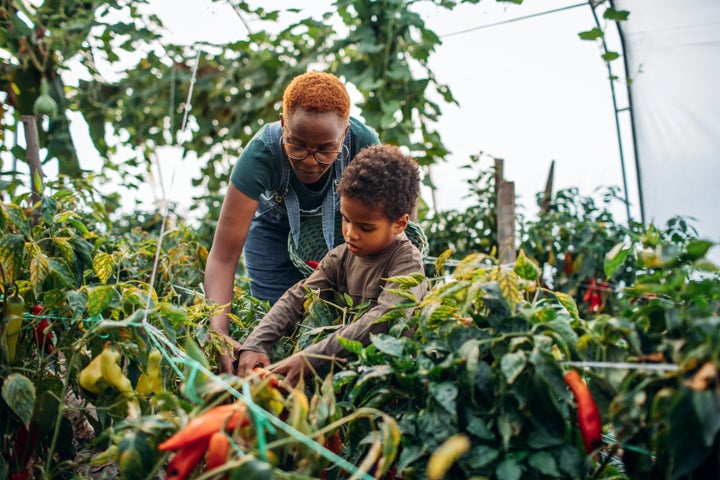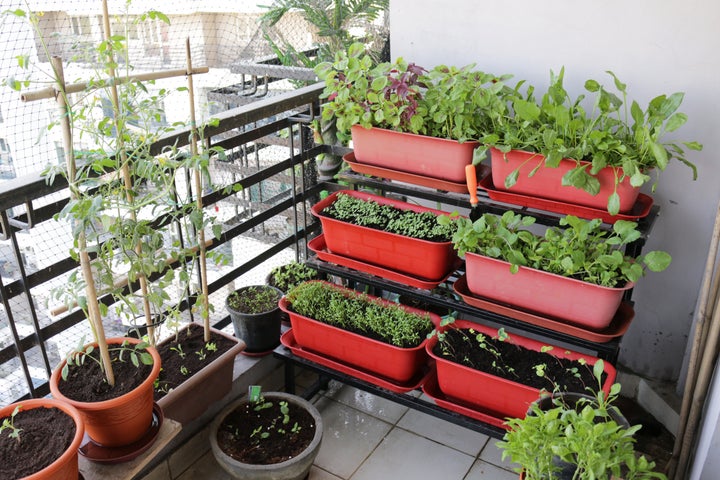You’re reading Here, Try This – our month-long plan encouraging you to try something new every day.
Gardening is both an art and a scientific experiment, with plenty of luck and skill thrown in for good measure. Hundreds of thousands of Brits across the country have been keeping their hands busy lately, tending to their own gardens, window boxes or allotments – so much so there’s even a seed shortage.
It’s no wonder that lockdown gardening has boomed. As anyone remotely green-fingered will tell you, time spent nurturing a garden is great for mind, body, and soul.
But where do you start? Look no further than this beginner’s guide. Arm yourself with the basics and there’s really no need to feel intimidated as a novice. Even well-seasoned gardeners don’t know it all. That’s one of the great joys of gardening. It’s the very definition of a work in progress.
Find your soil-mate
First things first, it’s important to know what type of soil you have because that will affect what you’re trying to grow. “The best thing to do is buy yourself a soil testing kit, which can be found in most garden centres and nurseries,” Steven Howes, director of The Real Gardener, tells HuffPost UK. “You stick them in the ground and it’ll tell you the pH level.”
This will tell you if your soil is more acidic or alkaline in makeup. Different types of plants like different types of soil – and while there isn’t a one soil-fits-all, most plants thrive in slightly acidic soil as it gives them better access to nutrients.

“Another good way to check the soil is by judging what’s surrounding the area and what’s flourishing in the soil,” says Howes. “Azaleas, camellia, and rhododendrons, for example, like acidic soil. You might want to mix in peat moss if a soil test shows that your soil is on the alkaline side.”
Despite the miserable January weather and not much seemingly growing, there’s plenty to be getting on with during the winter months. Howes recommends using this time to cultivate your soil – “soil amendments can be added to improve the soil structure, enhance drainage and change moisture retention” – as well as pulling out weeds to prep your garden for planting.
“Make sure you pull by hand. That way you’re putting air back into the soil, then you can top up with a nice sort of rich organic compost. It’s time-consuming to hand-pull weeds, but it’s rewarding and better for the environment.”
Growing season

Before you start throwing seeds in the ground and hoping for the best, do your research and learn about the different growing seasons and lengths of a plant’s life. This is particularly useful for annual plants, garden vegetables and flowers that only live for a year.
Refer to the gardener’s bible, otherwise known as the Royal Horticultural Society’s monthly calendar (or if you prefer books, the RHS Encyclopedia of Plants and Flowers, for a month by month breakdown of what to grow when.
″Snowdrops are usually one of the first signs of spring – lovely little white flowers poking through this time of year – as well as beautiful scented winter flowering shrubs,” says George Plumptre, chief executive of the National Gardening Scheme.
“From March to May, there are more signs of life. You move on to daffodils, tulips, and various perennials. And in the last few years, flowering shrubs like roses and perennial grasses have become very fashionable, and they’re pretty indestructible.”
Laying down your roots

When it comes to planting, you have two options: buying seeds to start from scratch or buying starter plants you can transplant into your garden.
Lots of vegetables and flowers are easy to grow from seed, making this the simpler and more affordable choice in many situations. “I always tell this to new gardeners, but whatever you’re growing, start small and simple,” says Plumptre.
This means investing in a seed tray. “If you sprinkle seeds directly into the ground, it’s a lot more complicated because you have to consider spacing and other natural elements. With a seed tray, you plant the seeds in individual holes, which you can keep indoors or in a greenhouse. Then you can transfer the seedlings outside and take them out one by one and put them in little mini individual pots.”
Buying plants, rather than seeds, may be preferable when a plant is difficult to grow from seed or the growing season is particularly short. But why not have a mixture? Experiment and enjoy the best of both worlds – learning as you go.
Location, location, location

Gardens come in all shapes and sizes, so it’s a matter of figuring out what will work for you and what’s within your reach. Whether you’re blessed with plenty of sun on your personal patch of land or you’re gardening in a shared allotment, or a small balcony with limited space, where you put certain plants matters.
“The number one mistake most gardeners make would be putting the wrong plants in the wrong location,” explains Howes. “What ends up happening is the plant either gets scorched, or not enough light, and it doesn’t flourish or flower. Ask nurseries for help. They’re more than happy to provide advice. And read the information on the labels of each plant that shows what it likes and dislikes.”
For those who don’t have a garden, you can still join in the gardening craze. In fact, gardening doesn’t even have to be an outside thing — growing plants on balconies or indoors can provide many of the same stress-reducing benefits as gardening outside, while also improving air quality in your home.
“Don’t be limited into think you need a lot of space, there are so many different ideas that you can use,” he adds. “Try your hand at living walls, drilling planters on to the walls, pots, and hanging baskets.”
Patience and persistence is key
Gardening is a slow and steady race. Don’t expect things to bloom overnight. Some plants will take two or three years to reach two their optimum size – or in the case of treeds, many years longer – so take that into consideration.
“Avoid overcrowding, you can either be patient and plant things with large gaps in between so that they can grow over,” Plumtre advises. “Or, you can be impatient and have the effect immediately, but you’re going to waste a lot of your time and effort by killing some of your plants in a couple of years’ time.
Not only that, there’s a lot of trial and error involved. Some plants will inexplicably die on you and that’s okay – it’s how you learn and grow as a gardener.
“It makes me so happy that so many people are taking up gardening, especially young people,” Plumtre adds. “It’s way more accessible compared to when I first started gardening 40 years ago. This is just what it should be. It shouldn’t be something that’s frightening and reserved for experts.”
Ultimately in gardening, there are no mistakes, only experiments. And every time you plant something, you get the chance to bloom a bit, as well as your garden.
